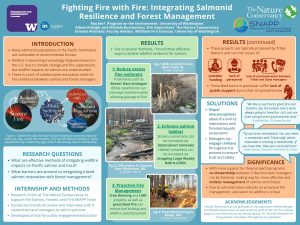Salmon, Forests, and Fire: Barriers to Collaboration, Integration of Holistic Practice
Planning for fire resilience is becoming increasingly difficult in the current fire regime. The intensity and severity of wildfires in the Western United States today call for attention not only for our health and safety, our forests, but our aquatic systems as well. There is an unfortunate deficiency in collaboration between terrestrial and aquatic restoration work in forested ecosystems, which poses a problem for salmon restoration and wildfire resilience. The aim of this study was to identify barriers to integrating salmon restoration with forest management for wildfire. I conducted interviews with a handful of members on the Science for Nature and People Partnership (SNAPP) team for Salmon, Forests, and Fire at The Nature Conservancy to uncover some of these barriers. One major trend was a lack of Tribal inclusion in land management, which encompasses a lack of funding, a lack of personnel, a lack of public support for projects proposed by Tribal Nations, and difficulties in communication between Tribal and county/state managers. How we should approach fire resilience is complex due to misconceptions from a lasting campaign against Indigenous practices such as prescribed burning, as well as administrative decisions affecting agencies such as the US Forest Service and the US Fish and Wildlife Service. It is necessary to increase awareness amongst the public and professional alike on fire and its interactions with forested and aquatic ecosystems. By garnering more support for prescribed fire programs and holistic salmonid restoration projects, co-stewardship of our forested ecosystems can continue to be fostered.
